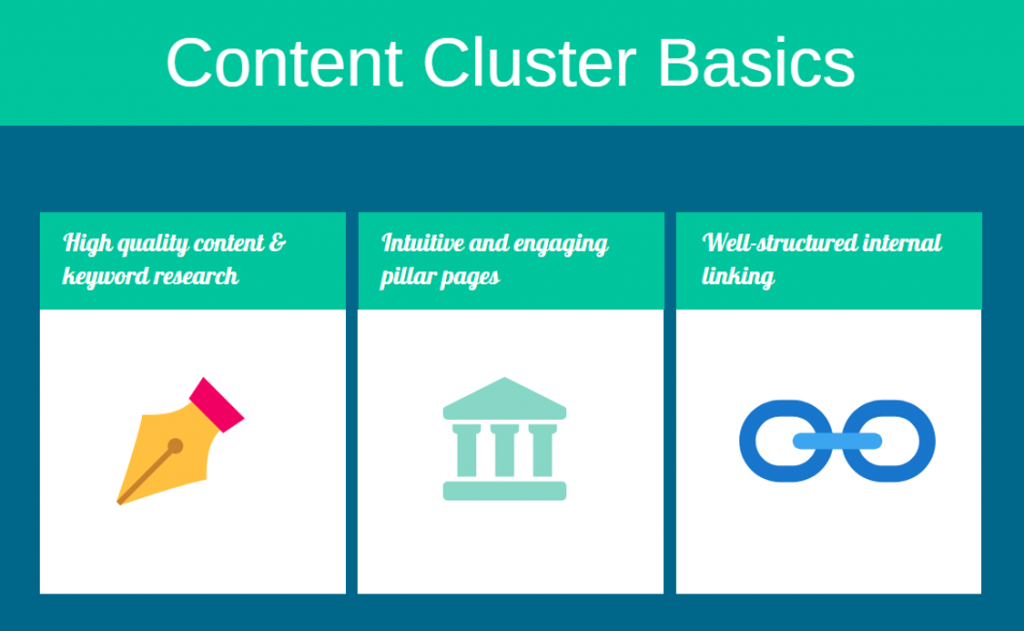No one knows for sure what direction Google’s algorithm will take as time progresses, but for now, it seems that content reigns supreme.
Blog content, video content, social media content, and a well-managed linking strategy moving users from one asset to the next are all essential to the digital marketer’s toolkit.
And while developing excellent content for your brand should be a priority, many professionals don’t realise that the organisation of your content is nearly as important.
In this post, we’ll cover some of the basics of how you can implement a content cluster strategy for your digital marketing campaign, and especially for your search engine optimisation (SEO) strategy.
Let’s start with the basics:
Contents
What is a Content Cluster Strategy?
Content clusters are basically what they sound like: pieces of content — blogs, photo albums, podcasts — that are organised around a central theme.
This grouping of content is a cluster.
Most sites online tend to more or less randomly post content, without much thought to their overall information architecture. This is frustrating for users, and makes it harder for Google to crawl your site.

In order to fully understand content clusters, it’s important to look at the components that make one up.
Content:
This one is a bit obvious, but it’s impossible to overstate.
You need to have high-quality content that users genuinely wish to read or engage with.
There are enough spammy sites online to last a lifetime; readers only want to read articles, watch videos, and listen to podcasts that promise a high quality and genuine informativeness.
It’s useful to use plenty of keywords when you write your content, but remember not to keyword stuff. Google will see right through you and penalise your site.
Hub or pillar pages:
Next, it’s important to have a “central” page that serves as the hub for all content surrounding a topic.
Let’s take a look at an example: Hausera’s blog incorporates several blog topics around a central subject with a writing style that establishes itself as a trendy purveyor of bathroom and kitchen fixtures and design trends.
And, rather than simply posting about topics at random, quickly surveying their site reveals that they’ve actually organised it by topic.

You can see that these articles on sinks, for instance, are located on a hub page where curious shoppers can easily find more content related to their interests.
You can think of pillar pages as the main train station in a large city. Every other station should link up to it, and once you’re there, you know exactly how to find your next stop.
Links, links, links: As we just mentioned, your central pillar page should have tons of internal links pointing users to the full suite of topics related to their interests. In addition to this, individual pieces of content should refer readers back to the pillar page, for ease of navigation.
And lastly, topics all within the same cluster should link to each other, to keep users engaged and increase the chances of conversion.
What Are the Benefits Of Content Clusters?
The benefits of using content clusters are pretty straightforward. There are two main benefits you’re aiming for when you organise your content.

First, it’s just easier for users.
Maybe you run a small business that specialises in women’s shoes. Your blog contains tons of helpful articles on how to style your shoes with cool outfits.
Users will want to easily be able to navigate your blog, moving from subtopic to subtopic without having to conduct another search.
By having information well-organised, users can go straight where they need to.
Second, it’s good SEO practice.
Google crawls sites to see how well-organised they are, and at least a portion of your ranking will be determined by how well laid-out your site is.
As Google gets smarter, it’s likely it will grow even better at determining which sites are structured in a way that creates a better user experience, so this is incredibly important as you look toward the future of SEO.

How Do I Implement Content Clusters?
The good news is that if you already have plenty of blog content, implementing content clustering shouldn’t be too difficult.
You can simply comb through your existing content and see what groupings these naturally fall into.
It’s a good idea to prioritise keyword research when you do this step. You can use a helpful plugin like Keywords Everywhere to find out what search terms are most relevant to your brand.
If you find that a lot of your content is lacking in keyword optimisation, simply revise and republish.
Once you’ve refreshed your content, you can get to work on making pillar pages. These are the central hubs that we referred to earlier.
Find high-quality, engaging topics that you can construct these pages around.
For instance, if your company sells meal-prepping kits, you can make engaging pillar pages on topics like “meal prepping for body-builders,” “fat-burning meals,” or “productivity hacks.”
Then, each of these pillar pages should link out to all the blog/video/podcast/image content that’s related to the central pillar.
Takeaway: content is vital in your digital marketing strategy. Optimise your content by organising information in a clear, engaging, and highly-crawlable way to see your SEO grow.
Final Thoughts
To figure out what type of content cluster will work best for your brand, consider the most relevant, newsworthy and compelling issues surrounding your brand or offer.
Also, by considering your customer’s interests, pain points and the solution you provide, you might also come up with some practical and interesting ideas for posts that will make up your next content cluster.
Once you’ve done some brainstorming around different topics for your new content campaigns, be sure that you are addressing your target audience’s concerns and delivering content that helps, entertains or both!
- About the Author...






One Response
It’s great articles like this that make it easier to stay at home and still feel productive. Great read👍🏼.